Barda, Azerbaijan
Barda (Azerbaijani: Bərdə) is the capital city of the Barda Rayon in Azerbaijan, located south of Yevlax and on the left bank of the Tartar river. It was the capital of Caucasian Albania perhaps since the end of the fourth century,[2] Barda became the chief city of the Islamic province of Arran, the classical Caucasian Albania, remaining so until the tenth century.[3]
Bərdə | |
|---|---|
City & Municipality | |
 Bərdə | |
| Coordinates: 40°22′28″N 47°07′36″E | |
| Country | |
| Rayon | Barda |
| Elevation | 76 m (249 ft) |
| Population (2010)[1] | |
| • Total | 41,277 |
| Time zone | UTC+4 (AZT) |
| • Summer (DST) | UTC+5 (AZT) |
| Area code(s) | +994 2020 |
Etymology
The name of the town derives from (Arabic: برذعة, romanized: Bardhaʿa) which derives from Old Armenian Partaw (Պարտաւ),[4] itself from Iranian *pari-tāva- 'rampart', from *pari- 'around' and *tā̆v- 'to throw; to heap up'.[5]
History
Ancient
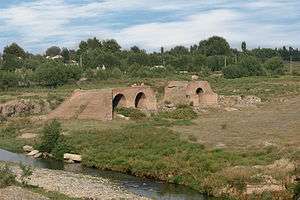
In the 460s AD, King Vache II of Caucasian Albania, acting under the orders of the Sasanian Emperor Peroz I, had founded the settlement known as Partav, which was initially called Perozapat, and replaced Qabala as the capital of Caucasian Albania.[6][7] According to the seventh-century atlas, the Ashkharhats'uyts', attributed to Anania Shirakatsi, Barda was known by the name of Partav (Partaw) during the period of late antiquity and was located in the district of Uti Aṛandznak in the province of Utik', which was at that time in the possession of Albania.[8] (The same author also mentions it among the provinces of Armenia).[7][9] In 552, Partav was made the catholicosal seat of the Church of Caucasian Albania. In the mid-seventh century, Javanshir, the lord of Gardman, led a movement that expelled the Persian marzpan from the province of Utik' and made Partav his capital and constructed churches and other buildings.[7] His deeds were chronicled by the Armenian historian Movses Kaghankatvatsi, who hailed from a neighboring village.
Medieval
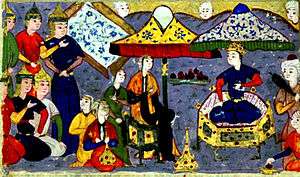
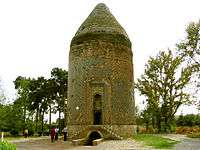
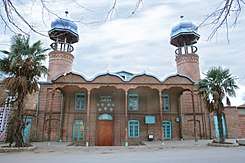
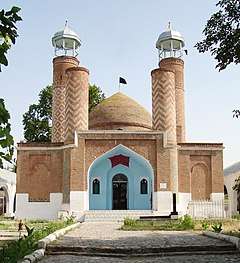
In about 645, Partav fell under the control of the Muslim Arabs and was referred to as "Barda" or "Barda'a" in Arabic. In ca. 789, it was made the second alternate capital (after Dvin) of the governor (ostikan) of the province of Arminiya.[10] Its governors strengthened the defenses of the city in order to counter the invasions of the Khazars attacking from the north.[3] In 768, the Catholicos of All Armenians, Sion I Bavonats'i, convoked an ecclesiastical council at Partav, which passed 24 canons that addressed issues relating to the administration of the Armenian Church and marriage practices.[7] By the ninth to tenth centuries, Barda had largely lost its economic importance to the nearby town of Ganja; the seat of the Catholicos of the Church of Albania was also moved to Bardak (Berdakur), leaving Partav as a mere bishopric.[7][11] According to the Muslim geographers Estakhri, Ibn Hawqal, and Al-Muqaddasi, the distinctive Caucasian Albanian language (which they called al-Raniya, or Arranian) persisted into early Islamic times, and was still spoken in Barda in the tenth century.[12] Thus, Ibn Hawkal mentioned that the people of Barda spoke Arranian,[13] while Estakhri stated that Arranian was the language of the "country of Barda."[14]
During this time, the city boasted a Muslim Arab population, as well as a substantial Christian community.[3] Barda was even the seat of a Nestorian,(Christian) Bishopric in the 10th century.
Referring to events in the late eleventh century, the twelfth-century Armenian historian Matthew of Edessa described Partav as an "Armenian city ["K'aghak'n Hayots'"], which is also called Paytakaran and located near the vast [Caspian] Sea."[15]
The same Muslim geographers describe Barda as a flourishing town with a citadel, a mosque (the treasury of Arran was located here), a circuit wall and gates, and a Sunday bazaar that was called "Keraki," "Korakī" or "al-Kurki" (a name derived from Greek κυριακή (kyriaki), the Lord's Day and Sunday, as the Armenian word kiraki is).[3][16][17] In 914, the city was captured by the Rus, who occupied it for six months. In 943, it was attacked once more by the Rus and sacked.[18] This may have been a factor in the decline of Barḏa in the second half of the tenth century, along with the raids and oppressions from the rulers of the neighboring regions, when the town lost ground to Beylaqan.[3]
Centuries of earthquakes and, finally, the Mongol invasions destroyed much of the town's landmarks, with the exception of the fourteenth century tomb of Ahmad Zocheybana, built by architect Ahmad ibn Ayyub Nakhchivani. The mausoleum is a cylindrical brick tower, decorated with turquoise tiles. There is also the more recently built Imamzadeh Mosque, which has four minarets.[19]
Modern
Agriculture is the main activity in the area. Local economy is based on the production and processing of cotton, silk, poultry and dairy products. The cease fire line, concluded at the end of the Nagorno-Karabakh War in 1994, is just a few kilometers west of Barda, near Terter.
Notable residents
- Khosrow II. Khosrow, the last great king of the Sasanian Empire, is first mentioned in the 580s, when was at Partaw (Barda), the capital of Caucasian Albania. During his stay there, he served as the governor of the kingdom, and managed to put an end to the Kingdom of Iberia and make it into a Sasanian province.[20]
- Mihranids of Caucasian Albania: Javanshir, Varaz-Tiridates I. etc.
- Arabic governors: Muhammad ibn Abi'l-Saj, etc.
- Paykar Khan Igirmi Durt. Qizilbash chieftain in the service of Safavid Persia in the late 16th and early 17th centuries. His career flourished in the southeastern Caucasus, where he ran the governments of Barda and Kakheti on behalf of Shah Abbas I until being overthrown in a Georgian uprising in 1625.
Notes
- World Gazetteer: Azerbaijan Archived June 22, 2011, at the Wayback Machine – World-Gazetteer.com
- Chaumont, M. L. "Albania." Encyclopaedia Iranica. July 29, 2011.
- Bosworth, C.E. "Barda'a." Encyclopaedia Iranica. December 15, 1988.
- Pourshariati, Parvaneh. Decline and Fall of the Sasanian Empire: the Sasanian-Parthian Confederacy and the Arab Conquest of Iran. London: I.B. Tauris, 2008, p. 116, note 613.
- (in Russian) Périkhanian, Anahit G. "Этимологические заметки" [Notes on Etymology]. Patma-Banasirakan Handes 1 (1982), 77-80.
- "The earlier capital of Albania seems to have lain north of this river (Kur), whereas the later capital Perozapat (Partav, Barda'a) was built by the Albanian Vach'e only under the Sasanian king Peroz (457-84)": Vladimir Minorsky, A History of Sharvan and Darband in the 10th-11th Centuries. Cambridge: Heffer and Sons, 1958.
- (in Armenian) Ulubabyan, Bagrat. «Պարտավ». Armenian Soviet Encyclopedia. Yerevan: Armenian Academy of Sciences, 1983, vol. 9, p. 210.
- Anania Shirakatsi (1992). The Geography of Ananias of Širak: Ašxarhacʻoycʻ, the Long and the Short Recensions. Trans. Robert Hewsen. Wiesbaden: Reichert, p. 66.
- Adontz, Nicholas (1970). Armenia in the Period of Justinian: The Political Conditions Based on the Naxarar System. Trans. and rev. Nina G. Garsoïan. Lisbon: Calouste Gulbenkian Foundation. p. 125*. In the long recension of the Ashkharats'uyts', this section, in Classical Armenian, reads: "Ուտի առ մտից կայ Երասխայ ընդ մէջ Արցախայ և Կուռ գետոյ. ունի գաւառս զոր Աղուանք ունին՝...Ուտի առանձնակ՝ յորում Պարտաւ քաղաք."
- Ter-Ghevondyan, Aram N. (1976). The Arab Emirates in Bagratid Armenia. Trans. Nina G. Garsoïan. Lisbon: Calouste Gulbenkian Foundation. pp. 36–37.
- Kirakos Gandzaketsi. History of the Armenians. Trans. Robert Bedrosian.
- Bosworth, C. E. "Arrān." Encyclopaedia Iranica.
- (in Russian) Арабские источники о населенных пунктах и населении Кавказской Албании и сопредельных областей (Ибн Руста, ал-Мукаддасий, Мас’уди, Ибн Хаукаль)
- (in Russian) Караулов Н. А. Сведения арабских писателей X и XI веков по Р. Хр. о Кавказе, Армении и Адербейджане
- Matthew of Edessa (1993). Armenia and the Crusades: Tenth to Twelfth centuries: The Chronicle of Matthew of Edessa. Trans. Ara E. Dosturian. Lanham: University Press of America, p. 151.
- Wheatley, Paul. The Places Where Men Pray Together: Cities in Islamic lands, Seventh through the Tenth Centuries. Chicago: University of Chicago Press, 2001. ISBN 0-226-89428-2, ISBN 978-0-226-89428-7, p 159.
- Estakhri states that there was a Sunday bazaar in Barda, known locally as "Koraki," which in the opinion of scholar George Bournoutian derives directly from the Armenian, not the Greek, rendition of the word Sunday ("Kiraki"). On this basis, Bournoutian speculates that the city still had a significant Armenian element during the tenth century: see Jamal Javanshir Qarabaghi, Two Chronicles on the History of Karabagh: Mirza Jamal Javanshir’s Tarikh-e Karabagh and Mirza Adigozal Beg’s Karabagh-name. Introduction and annotated translation by George A. Bournoutian. Costa Mesa, CA: Mazda Publishers, 2004, p. 40, note 2.
- Kennedy, Hugh (2004). The Prophet and the Age of the Caliphates: The Islamic Near East from the 6th to the 11th Century, 2nd ed. Harlow: Longman, p. 256.
- Turánszky, Ilona (1979). Azerbaijan, mosques, turrets, palaces. Corvina Kiadó. p. 56. ISBN 978-963-130321-6.
- Howard-Johnston 2010.
Further reading
- Barthold, Wilhelm (1987). "Bard̲h̲aʿa". In Houtsma, Martijn Theodoor (ed.). E.J. Brill's first encyclopaedia of Islam, 1913–1936, Volume II: Bābā Fighānī–Dwīn. Leiden: BRILL. p. 656. ISBN 90-04-08265-4.
- Dunlop, D.M. (1960). "Bard̲h̲aʿa". In Gibb, H. A. R.; Kramers, J. H.; Lévi-Provençal, E.; Schacht, J.; Lewis, B. & Pellat, Ch. (eds.). The Encyclopaedia of Islam, New Edition, Volume I: A–B. Leiden: E. J. Brill. pp. 1040–1041. OCLC 495469456.
- Ter-Ghewondyan, Aram (1976) [1965]. The Arab Emirates in Bagratid Armenia. Translated by Nina G. Garsoïan. Lisbon: Livraria Bertrand. OCLC 490638192.
- Ulubabyan, Bagrat (1981). Դրվագներ Հայոց արևելից կողմանց պատմության [Episodes from the History of the Eastern Regions of Armenia] Yerevan: Armenian Academy of Sciences.
- Howard-Johnston, James (2010). "ḴOSROW II". Encyclopaedia Iranica, Online Edition. Retrieved 9 November 2013.CS1 maint: ref=harv (link)
.svg.png)